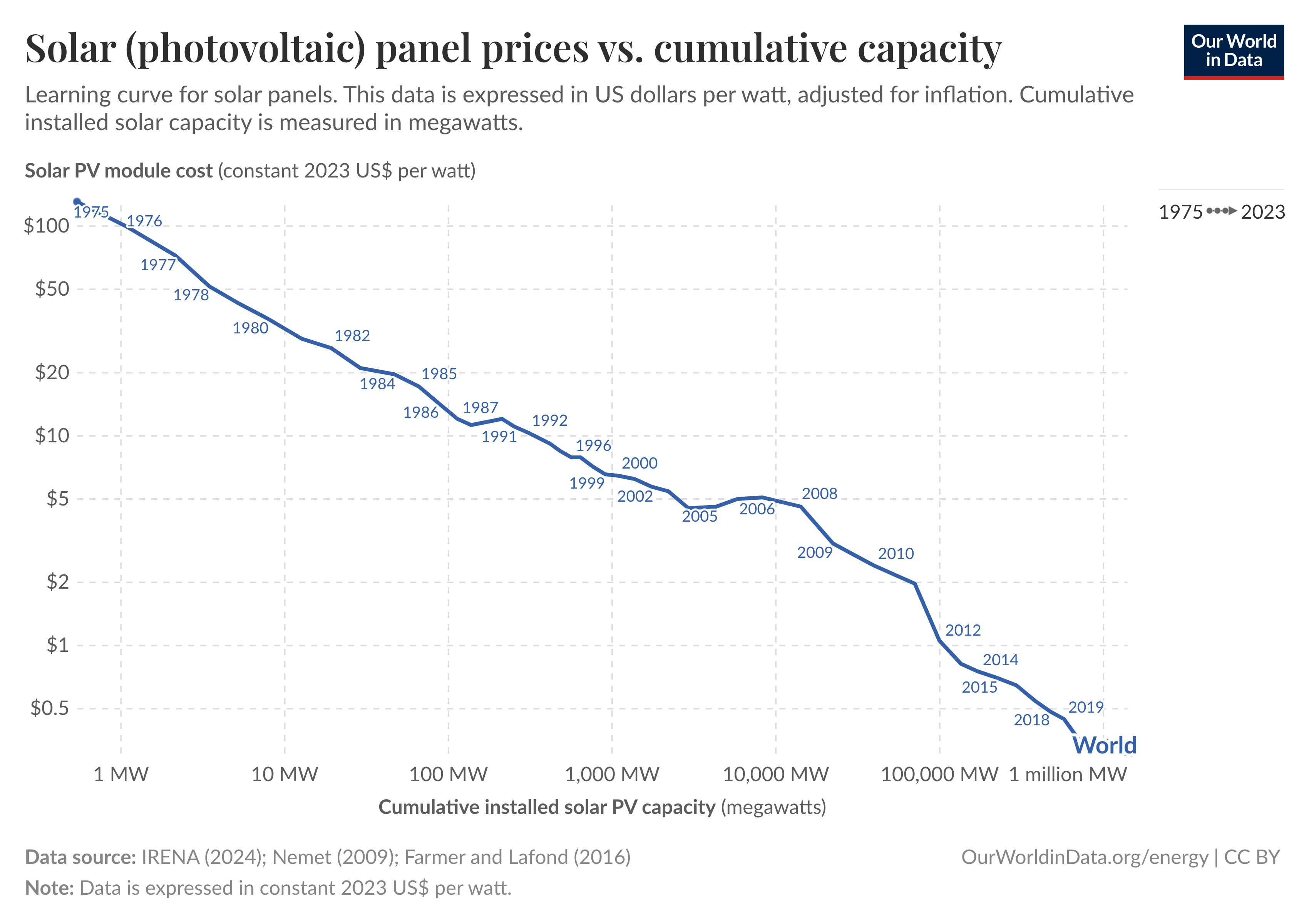Beyond intermittency: How battery hybrid renewables are redefining baseload power in emerging markets

Executive Summary
The global energy landscape is experiencing a fundamental transformation, driven by the convergence of dramatically reduced renewable energy costs and revolutionary advances in battery storage technology. This transformation is particularly profound in Africa, where the traditional grid infrastructure paradigm can be leapfrogged by a new generation of hybrid renewable projects that promise to deliver baseload power characteristics at competitive costs, equal or lower than fossil fuel alternatives.
As renewable energy deployment accelerates globally, with over 2,600 gigawatts of projects awaiting grid connection in the United States alone¹ and similar backlogs emerging across Europe and Asia, the industry is confronting a critical challenge: how to integrate variable renewable generation without compromising grid stability. The answer increasingly lies in battery-hybrid renewable systems that fundamentally reimagine how clean energy projects interact with electrical grids.
The Grid Integration Challenge: A Global Crisis in the Making
The Hidden Burden of Renewable Integration
For decades, electrical grids in developed countries have quietly absorbed the costs and complexities of balancing, stabilizing, and regulating electricity supply. When renewable energy first emerged as a viable alternative to fossil fuels, projects were typically connected to existing grids where operators assumed responsibility for managing intermittency through elaborate systems of backup generation, demand response, and increasingly, grid-scale battery storage.
This approach worked when renewable penetration remained modest. However, the explosive growth in renewable deployment has exposed fundamental limitations in grid infrastructure globally. According to Lawrence Berkeley National Laboratory, active capacity in U.S. interconnection queues has increased nearly eight-fold over the last decade, reaching 2,600 gigawatts, more than twice the total installed capacity of the existing U.S. power plant fleet¹. In Europe, the situation is equally challenging, with over 1,700 gigawatts of renewable energy projects blocked due to grid congestion and €7.2 billion of renewable generation was curtailed (wasted) in 2024 across just seven European countries².
The Dual Challenge: Wires and Stability
The grid connection backlog stems from two interconnected challenges. First, there is the physical infrastructure limitation: the need for more transmission lines, transformers, and substations to move power from generation sites to consumption centers. Second, and perhaps more critically, is the grid stabilization requirement. Traditional grids were designed for predictable, dispatchable generation from large thermal power plants. The integration of variable renewable sources fundamentally disrupts this paradigm.
Consider a standard 100-megawatt solar project operating at a typical capacity factor of 25%. Such a facility generates approximately 219,000 megawatt-hours annually but requires the grid operator to maintain equivalent dispatchable backup capacity for times when solar generation is unavailable. From a system perspective, this means building 100 megawatts of capacity twice, once for the solar farm and once for backup generation. This redundancy significantly increases total system costs and infrastructure requirements.
The International Energy Agency projects that global electricity demand will grow substantially through 2030, with Africa alone requiring an estimated 50-70 gigawatts of new generation capacity to meet demand growth of 5% annually through 2027³, equivalent to adding the entire installed capacity of a country like Egypt every two years. Meeting this demand while simultaneously integrating renewable generation presents an unprecedented challenge for grid operators worldwide, but particularly in emerging markets where grid infrastructure is already constrained.
The Technology Convergence Revolution: Economics Shifting the Paradigm
The Dramatic Cost Decline Story
The economic foundation for battery-hybrid renewable systems rests on one of the most remarkable cost reduction stories in industrial history. Solar photovoltaic costs have fallen by 90% over the past decade, following Wright's Law, the principle that technology costs decline predictably as cumulative production increases. Since 2010, solar installation costs have declined by 82%, with module prices dropping from $2.50 per watt to under $0.27 per watt today⁴.

Wind technology has experienced similar transformations, with costs declining by 70% over the same period. Modern wind turbines achieve capacity factors of 35% to 55% in quality resource areas, dramatically improving the economics of wind generation. The learning curve for wind technology shows an 18.9% average price decline for every doubling of cumulative installed capacity⁴.
However, the most dramatic cost reductions have occurred in battery storage technology. Lithium-ion battery prices have plummeted from $1,400 per kilowatt-hour in 2010 to just $115 per kilowatt-hour in 2024, a staggering 97% reduction⁴.
The Tipping Point for Hybrid Systems
This convergence of cost reductions across solar, wind, and battery technologies creates a unique inflection point where hybrid renewable systems with storage can deliver genuine baseload characteristics at costs that undercut fossil fuel alternatives. The International Renewable Energy Agency suggests that lithium-ion battery costs for stationary applications could fall below $200 per kilowatt-hour by 2030, enabling widespread deployment of hybrid systems⁶.
Battery storage deployment is accelerating globally, with the technology being the fastest-growing energy segment. Deployment more than doubled year-over-year, driven primarily by these cost reductions and the increasing need for grid flexibility⁷. In the United States alone, battery storage capacity additions reached 7.4 gigawatts in the first nine months of 2024, representing a 64% increase over the previous year⁸.
The Hybrid Solution: Redefining Baseload Power
Engineering Complementarity
The technical innovation at the heart of battery-hybrid renewable systems lies in the strategic integration of wind and solar generation to exploit their natural complementary patterns. Solar photovoltaic systems generate maximum output during daylight hours, typically peaking between 10 AM and 3 PM. Wind resources often demonstrate inverse patterns, with wind speeds frequently increasing during evening and nighttime hours when solar generation diminishes.
This complementarity creates substantial advantages for hybrid systems. While individual solar installations achieve capacity factors of 25% to 35% and wind projects reach 35% to 50%, strategically designed hybrid projects can achieve combined capacity factors exceeding 60%. More importantly, the complementary generation profiles naturally smooth output variability, reducing the battery storage capacity required to achieve baseload characteristics by 40% to 60% compared to single-technology installations⁹.
A hybridized renewable project operating at 75% capacity factor can produce 657,000 megawatt-hours annually from the same 100-megawatt grid connection, three times the output of a standalone solar facility while providing controllable, dispatchable power that actually stabilizes the grid rather than stressing it.
Grid Services: From Burden to Asset
Unlike traditional renewable projects that create challenges for grid operators, battery-hybrid systems provide essential grid services that enhance system stability. These projects can deliver¹⁰:
Frequency Regulation: Battery systems respond to frequency deviations within milliseconds, providing more accurate and faster regulation than traditional thermal generators. In California, batteries providing frequency regulation services have become essential for maintaining grid stability as renewable penetration increases.
Voltage Support: Strategic placement of battery-hybrid projects helps manage voltage levels across transmission networks, reducing the need for expensive grid upgrades.
Spinning Reserve: Battery systems can provide immediate response to generation losses, with response times measured in milliseconds rather than minutes.
Black Start Capability: Modern battery systems can restart portions of the grid following blackouts, a service traditionally provided only by specific types of conventional generators.
Inertial Response: Advanced inverter controls enable battery-hybrid systems to provide synthetic inertia, mimicking the stabilizing effects of rotating masses in conventional generators.
Economic Analysis: The Business Case for Transformation
Total System Cost Revolution
The economic advantages of battery-hybrid renewable systems extend beyond simple generation costs to encompass total system benefits. When accounting for avoided transmission upgrades, reduced backup generation requirements, and the value of grid services provided, hybrid systems often deliver lower total system costs than traditional approaches to renewable integration.
The shift from grid-managed intermittency to project-level baseload capability represents a fundamental reallocation of costs and responsibilities. While this increases individual project costs, with a hybrid system with storage costing 30% to 50% more than a simple solar installation, it dramatically reduces system-wide infrastructure requirements and operational complexity.
The stark reality of baseload premiums reveals the true value of firm power. While simple solar and wind projects routinely secure power purchase agreements at $30 to $50 per megawatt-hour in competitive markets, utilities continue signing contracts for dispatchable generation at $80 to $150 per megawatt-hour. This represents a premium of 100% to 300% for the reliability and grid services that baseload power provides.
Nuclear power, despite its zero-carbon credentials, routinely requires strike prices above $100 per megawatt-hour to be economically viable. Gas peaker plants, which may operate only a few hundred hours annually, can command capacity payments that translate to equivalent energy costs exceeding $200 per megawatt-hour. Even geothermal projects, with capacity factors similar to what battery-hybrid renewables can achieve, secure power purchase agreements at two to three times the price of simple solar installations.
This pricing differential reflects a fundamental market truth: grid operators and industrial customers will pay substantial premiums for power they can rely on. Battery-hybrid renewable projects that deliver 75% capacity factors with full dispatchability can capture these baseload pricing premiums while offering lower total costs than traditional thermal generation.

Long-term Price Stability Advantage
Beyond immediate cost considerations, battery-hybrid renewable projects offer unprecedented long-term price stability. Once constructed, these facilities have minimal variable operating costs and can offer fixed-price power purchase agreements for 20 to 30 years. This contrasts sharply with fossil fuel generation, where fuel price volatility creates ongoing uncertainty for both generators and consumers.
For African economies particularly vulnerable to global commodity price fluctuations, this price stability represents enormous value. Countries can effectively hedge their entire electricity sectors against international fuel price volatility while simultaneously advancing energy independence and climate objectives.
The African Opportunity: Leapfrogging Traditional Infrastructure
Addressing Unique Continental Challenges
Africa's electricity landscape presents both enormous challenges and unprecedented opportunities for battery-hybrid renewable deployment. The continent possesses exceptional renewable resources, with the International Renewable Energy Agency estimating nearly unlimited solar capacity potential of 10 terawatts, substantial hydro resources of 350 gigawatts, and significant wind potential of 110 gigawatts¹². Yet 600 million Africans still lack access to electricity, with the International Energy Agency projecting that 33% of all Africans will remain without electricity access in 2030 under current policies¹³.
The traditional approach of building large centralized power plants connected by extensive transmission networks may not be optimal for Africa's development needs. Battery-hybrid renewable projects offer an alternative pathway that can deliver reliable power more quickly and cost-effectively, particularly in areas where grid infrastructure is limited or non-existent.
Pioneering Projects Leading the Way
Africa is already emerging as a testing ground for innovative battery-hybrid approaches. In Senegal, Africa's first frequency regulation-dedicated battery storage project combines 16 megawatts of solar with a 10-megawatt/20-megawatt-hour battery system, providing critical grid stability services under a 20-year power purchase agreement with the national utility. The project increases the country's spinning reserve by 40% while demonstrating the viability of battery storage for grid services in African markets¹⁴.
South Africa's Battery Energy Storage Independent Power Producer Procurement Programme represents one of the world's most comprehensive frameworks for deploying grid-scale battery storage. The program specifically targets four-hour duration storage systems capable of addressing evening peak demand while providing comprehensive ancillary services including frequency regulation, voltage support, and black start capability¹⁵.
Kenya, which the International Energy Agency identifies as on track to achieve universal electricity access by 2030, has emerged as a particularly promising market for hybrid renewable deployment. The country's exceptional wind resources, combined with abundant solar resources, create ideal conditions for hybrid projects that can deliver reliable baseload power¹⁶.
Accelerating Industrial Development
Battery-hybrid renewable projects can catalyze industrial development across Africa by providing the reliable, cost-competitive power that energy-intensive industries require. Applications ranging from mineral processing and fertilizer production to data centers and manufacturing can be directly coupled with hybrid renewable systems, creating new economic opportunities while avoiding the carbon-intensive development pathways followed by industrialized nations.
The ability to provide reliable power for industrial applications without extensive grid infrastructure investments particularly benefits remote mining operations and agricultural processing facilities. These projects can be developed and operational within 18 to 24 months, compared to the decade or longer required for traditional large-scale power plants and associated transmission infrastructure.
Implications for the Energy Transition
Redefining Grid Planning Paradigms
The emergence of battery-hybrid renewable systems as viable baseload power sources necessitates fundamental changes in how utilities and regulators approach grid planning. Rather than viewing renewable integration as a challenge to be managed, grid operators must recognize hybrid projects as grid assets that can provide superior technical performance compared to traditional thermal generation.
This shift requires updating interconnection standards to properly value the grid services that battery-hybrid systems provide. Current interconnection processes, designed for traditional generators, often fail to recognize the unique capabilities of hybrid systems, creating unnecessary barriers to deployment. Regulatory frameworks must evolve to enable hybrid projects to stack multiple value streams, including energy, capacity, and ancillary services, reflecting their full contribution to grid reliability.
Financing and Investment Considerations
The capital-intensive nature of battery-hybrid projects, with higher upfront costs than simple renewable installations, requires adapted financing approaches. However, the superior economics over project lifetimes, including premium power purchase agreement pricing and ancillary service revenues, create attractive investment opportunities.
Development finance institutions and climate funds are increasingly recognizing the transformative potential of battery-hybrid systems for emerging markets. The ability to deliver reliable, clean baseload power aligns with both development objectives and climate goals, making these projects attractive for concessional financing and risk mitigation instruments.
The Path Forward for Implementation
Successful deployment of battery-hybrid renewable systems at scale requires coordinated action across multiple stakeholders. Governments must establish clear regulatory frameworks that recognize and compensate for the full value these systems provide. Utilities need to adapt planning processes and operational practices to integrate hybrid projects as core grid assets. Developers must build capabilities in hybrid system design and optimization, moving beyond single-technology expertise.
Technical standards organizations play a critical role in establishing appropriate codes and standards for hybrid systems, ensuring interoperability and grid stability as deployment scales. The development of local expertise in battery-hybrid system design, installation, and maintenance will be essential for sustainable deployment, particularly in African markets.
Conclusion: A New Energy Paradigm Emerges
The convergence of dramatically reduced costs for solar, wind, and battery storage technologies has created an inflection point in global energy markets. Battery-hybrid renewable systems now offer a viable alternative to traditional approaches for delivering reliable, baseload power, an alternative that is particularly compelling for emerging markets seeking to expand electricity access while avoiding carbon-intensive development pathways.
For Africa, where electricity demand is forecast to grow substantially over the coming decade, battery-hybrid renewable projects offer a unique opportunity to leapfrog traditional infrastructure constraints. By delivering baseload power characteristics at competitive costs while providing essential grid services, these systems can accelerate electrification, support industrial development, and advance climate objectives simultaneously.
The transformation from intermittent renewable generation to controllable baseload power through battery-hybrid systems represents more than a technical evolution; it signals a fundamental reimagining of how electrical grids can operate in the 21st century. As deployment accelerates and costs continue to decline, battery-hybrid renewable systems will increasingly define the future of electricity generation, particularly in markets where traditional infrastructure approaches have failed to deliver universal access to reliable, affordable power.
The question is no longer whether battery-hybrid renewable systems can deliver baseload power, but rather how quickly the industry can scale deployment to meet growing global electricity demand while simultaneously addressing climate imperatives. For developers, investors, and policymakers focused on Africa's energy future, the message is clear: the age of baseload renewable power has arrived, and with it, unprecedented opportunities to transform the continent's energy landscape.
About the Author
Charles Haworth is the Chief Technology Officer at Modaso Energy, where he focuses on advancing renewable energy solutions across African markets. With 18 years of experience in the renewable energy industry. His expertise spans technical project design, grid integration strategies, and the development of hybrid renewable systems optimized for emerging market conditions.
Charles holds extensive experience in structuring innovative energy solutions that address the unique challenges of African electricity markets, with particular focus on combining wind, solar, and battery storage technologies to deliver reliable, grid-supportive power. He maintains an active network within the global renewable energy industry, including relationships with original equipment manufacturers, engineering consultancies, and financial institutions essential for successful project development in frontier markets.
References
- Lawrence Berkeley National Laboratory. (2024). "Grid connection backlog grows by 30% in 2023, dominated by requests for solar, wind, and energy storage." Energy Markets & Policy. Available at: https://emp.lbl.gov/news/grid-connection-backlog-grows-30-2023-dominated-requests-solar-wind-and-energy-storage
- Beyond Fossil Fuels. (2024). "Over 1,700 GW of renewable energy blocked in Europe due to grid congestion." The European Times, August 2025.
- ESI Africa. (2025). "Africa: Electricity demand set to increase by 5% through to 2027." February 14, 2025.
- International Renewable Energy Agency (IRENA) and industry sources. Cost reduction data compiled from multiple sources including IRENA reports and industry analysis.
- Cole, W. & Karmakar, A. (2023). "Cost Projections for Utility-Scale Battery Storage: 2023 Update." National Renewable Energy Laboratory. NREL/TP-6A40-85332.
- International Renewable Energy Agency. (2017). "Battery storage and renewables: costs and markets to 2030." IRENA, Abu Dhabi.
- International Energy Agency. (2024). "Renewables 2024 - Executive Summary." IEA, Paris.
- Deloitte. (2025). "2025 Renewable Energy Industry Outlook." Deloitte Insights.
- Analysis based on capacity factor calculations from Global Wind Atlas and Global Solar Atlas data.
- Kumar, G.V.B. & Palanisamy, K. (2020). "A Review of Energy Storage Participation for Ancillary Services in a Microgrid Environment." Inventions, 5(4), 63.
- Frontiers in Energy Research. (2022). "A review of battery energy storage systems for ancillary services in distribution grids: Current status, challenges and future directions." August 16, 2022.
- International Renewable Energy Agency. (2021). "The Renewable Energy Transition in Africa." IRENA, Abu Dhabi.
- International Energy Agency. (2022). "Africa Energy Outlook 2022 - Key Findings." IEA, Paris.
- Energy Storage News. (2023). "West Africa's 'first frequency regulation-dedicated' BESS financed in Senegal." June 26, 2023.
- Discovery Alert. (2025). "Battery Energy Storage Independent Power Producer Procurement Programme: South Africa's Grid Transformation." January 2025.
- International Energy Agency. (2023). "Kenya Energy Access Report." Referenced in ESI Africa reporting.

.svg)


.svg)